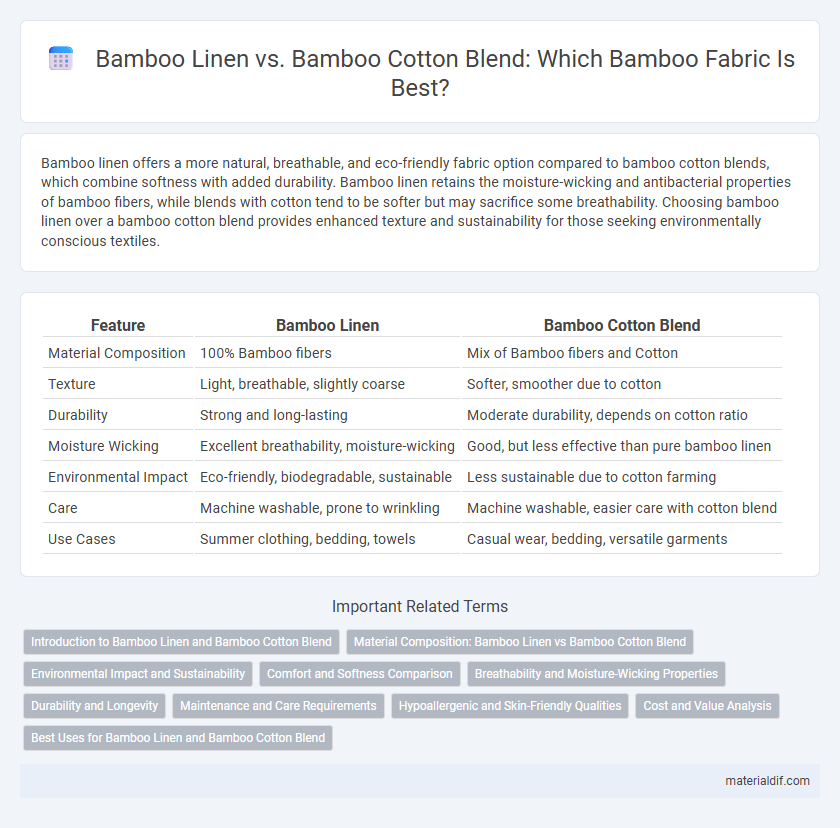Bamboo linen offers a more natural, breathable, and eco-friendly fabric option compared to bamboo cotton blends, which combine softness with added durability. Bamboo linen retains the moisture-wicking and antibacterial properties of bamboo fibers, while blends with cotton tend to be softer but may sacrifice some breathability. Choosing bamboo linen over a bamboo cotton blend provides enhanced texture and sustainability for those seeking environmentally conscious textiles.
Table of Comparison
| Feature | Bamboo Linen | Bamboo Cotton Blend |
|---|---|---|
| Material Composition | 100% Bamboo fibers | Mix of Bamboo fibers and Cotton |
| Texture | Light, breathable, slightly coarse | Softer, smoother due to cotton |
| Durability | Strong and long-lasting | Moderate durability, depends on cotton ratio |
| Moisture Wicking | Excellent breathability, moisture-wicking | Good, but less effective than pure bamboo linen |
| Environmental Impact | Eco-friendly, biodegradable, sustainable | Less sustainable due to cotton farming |
| Care | Machine washable, prone to wrinkling | Machine washable, easier care with cotton blend |
| Use Cases | Summer clothing, bedding, towels | Casual wear, bedding, versatile garments |
Introduction to Bamboo Linen and Bamboo Cotton Blend
Bamboo linen, derived from bamboo fibers processed into a natural, breathable fabric, offers exceptional moisture-wicking and antibacterial properties ideal for sensitive skin. In contrast, bamboo cotton blend combines bamboo fibers with cotton, enhancing durability and softness while maintaining bamboo's eco-friendly benefits and breathability. Both fabrics present sustainable options, with bamboo linen leaning towards lightweight, textured feel and bamboo cotton blends providing a balanced softness and strength suitable for everyday use.
Material Composition: Bamboo Linen vs Bamboo Cotton Blend
Bamboo linen consists primarily of bamboo fibers processed into a durable, breathable fabric with natural antibacterial properties, making it highly sustainable and moisture-wicking. In contrast, a bamboo cotton blend combines bamboo fibers with cotton, enhancing softness and reducing cost while maintaining breathability and durability. The blend typically ranges from 40-60% bamboo and 40-60% cotton, offering a balanced fabric that merges the eco-friendliness of bamboo with the softness of cotton.
Environmental Impact and Sustainability
Bamboo linen offers superior environmental benefits compared to bamboo cotton blends, as it uses fewer pesticides and less water during production, supporting sustainable farming practices. Bamboo cotton blends often rely on conventional cotton cultivation, which typically consumes significant water and involves heavy pesticide use, increasing their ecological footprint. Choosing bamboo linen contributes to reduced resource consumption and lower carbon emissions, promoting a more sustainable textile industry.
Comfort and Softness Comparison
Bamboo linen offers a crisp texture with excellent breathability but feels slightly rougher compared to bamboo cotton blend, which combines the smoothness of cotton with the moisture-wicking properties of bamboo for enhanced softness. Bamboo cotton blend fabrics provide superior comfort due to their natural fibers, resulting in a gentle, plush feel ideal for sensitive skin. The blend's elasticity and softness outperform bamboo linen, making it a preferred choice for everyday wear and bedding that demands ultimate comfort.
Breathability and Moisture-Wicking Properties
Bamboo linen offers superior breathability due to its natural fiber structure, allowing better air circulation and keeping the fabric cool in warm conditions. Bamboo cotton blends enhance moisture-wicking properties by combining bamboo's absorbency with cotton's softness, drawing sweat away from the skin more efficiently. Both fabrics support temperature regulation, but bamboo linen excels in ventilation, while bamboo cotton blends provide balanced comfort and moisture management.
Durability and Longevity
Bamboo linen offers superior durability and longevity compared to bamboo cotton blends due to its higher fiber strength and natural resistance to wear and tear. Bamboo cotton blends tend to be softer but may degrade faster over time as cotton fibers weaken with repeated washing. Choosing bamboo linen ensures longer-lasting fabric performance, making it ideal for products requiring extended durability.
Maintenance and Care Requirements
Bamboo linen requires gentle washing in cold water and air drying to maintain its natural fibers and avoid shrinkage, while bamboo cotton blends are more durable and can withstand machine washing on a gentle cycle. Both materials benefit from avoiding bleach and high heat drying to prevent damage, but bamboo cotton blends tend to be less prone to wrinkling and easier to iron. Proper care extends the lifespan of bamboo fabrics by preserving their softness and breathability.
Hypoallergenic and Skin-Friendly Qualities
Bamboo linen offers superior hypoallergenic properties due to its natural antimicrobial and antibacterial fibers, reducing the risk of skin irritations and allergies. Bamboo cotton blends retain much of these skin-friendly qualities while adding the softness and durability of cotton, making them ideal for sensitive skin and everyday use. Both fabrics promote breathability and moisture-wicking, ensuring comfort and minimizing allergic reactions.
Cost and Value Analysis
Bamboo linen typically offers higher durability and breathability but comes at a premium cost compared to bamboo cotton blends, which are more affordable and softer due to the cotton content. The blend balances cost-effectiveness and comfort, making it a popular choice for budget-conscious consumers seeking eco-friendly options. Evaluating long-term value, bamboo linen's longevity and moisture-wicking properties often justify the initial investment over bamboo cotton blends.
Best Uses for Bamboo Linen and Bamboo Cotton Blend
Bamboo linen offers superior breathability and moisture-wicking properties, making it ideal for summer clothing, lightweight shirts, and breathable home textiles such as curtains and bed linens. Bamboo cotton blend combines the softness of cotton with the durability and eco-friendliness of bamboo, perfect for everyday wear, casual t-shirts, and versatile bedding that requires a balance of comfort and longevity. Choosing between bamboo linen and bamboo cotton blend depends on whether lightweight breathability or soft durability is the priority for the intended use.
Bamboo linen vs Bamboo cotton blend Infographic

 materialdif.com
materialdif.com